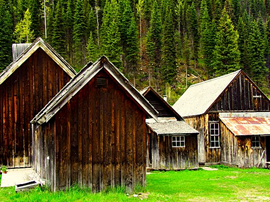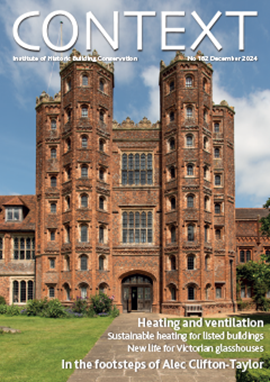Heritage building skills and live-site training
A project enabled large cohorts of trainees to participate in heritage, in a scenario that complied with public-sector procurement and other construction-sector regulations.
Contents |
Introduction
Historic England’s (HE) five-year heritage building skills programme aims to reduce shortages in heritage construction skills while improving the condition of sites on HE’s heritage-at-risk register. To do this, it is pioneering a new training model in the north of England. This has two main elements:
- vocational training placements available in three tiers, enabling craftspeople to gain direct experience at different critical points in their careers
- live-site training with expert teams at some of England’s most significant historic buildings.
The tiers of training are designed to promote career progression into and through heritage construction, structured as follows:
- Tier 1, Prepare: nine-week placements with heritage construction firms for students on full-time construction courses
- Tier 2, Enter: multi-year apprenticeships with heritage construction companies, allowing students to complete a mainstream construction qualification
- Tier 3, Sustain: flexible opportunities for work-based training with specialist heritage companies
All the trainees are recruited by HE and work in a host firm. They come together at live-site conservation projects each year to learn about heritage conservation as a values-based and interdisciplinary activity that considers multiple perspectives. Packaged together with classroom teaching, simulated craft sessions and site visits, the live-site works form part of an overall training offer that is steered by 15 learning outcomes. The opportunity is available to all trainees on the heritage building skills (HBS) programme. Tier 2 and 3 trainees spend longer and engage in the most advanced sessions, whereas Tier 1s attend for a shorter period for sessions, commensurate with their placement and career point.
| Learning outcome | Evaluation question: I am confident… | Change |
| 1 | In my knowledge that old and historic buildings are a finite resource | +21.6% |
| 2 | In my knowledge that historic buildings are valued by different people for different reasons | +19.4% |
| 3 | In my knowledge about the different heritage values | +18.8% |
| 4 | In my knowledge that the sum of a building’s values is called its significance | +24.4% |
| 5 | In my knowledge that when an old building is conserved, repaired or restored, it is good practice to try and conserve as much significance as possible | +3.6% |
| 6 | In my understanding that old buildings (particularly those built before 1919) are constructed differently to modern buildings, requiring particular skills and materials to conserve their significance | +6.8% |
| 7 | In my understanding that old buildings (particularly those built before 1919) require particular skills and materials to maintain performance characteristics that allow water to permeate into and evaporate from the building’s fabric | +21.4% |
| 8 | In my understanding that conservation is compatible with works to retrofit historic buildings; that we should be able to improve the energy efficiency of historic buildings while conserving their significance | +19% |
| 9 | In my ability to apply my understanding of the significance, construction methods and performance characteristics of historic buildings to interpreting how far plans for conservation include the like-for-like repair of historic features relevant to my trade | +24.2% |
| 10 | In my ability to apply my understanding of the significance, construction methods and performance characteristics of historic buildings to interpreting how far plans for conservation include the reinstatement of historic features relevant to my trade | +27.4% |
| 11 | In my ability to apply my understanding of the significance, construction methods and performance characteristics of historic buildings to interpreting how far plans for conservation include the adaptation of historic features relevant to my trade | +19.8% |
| 12 | In my ability to consider the advantages and disadvantages of using like for like repair to conserve a historic building | +19.2% |
| 13 | In my ability to consider the advantages and disadvantages of reinstating historic features to conserve a historic building | +19% |
| 14 | In my ability to consider the advantages and disadvantages of adapting historic buildings for conservation | +2.2% |
| 15 | In being able to evaluate the different trades needed on a conservation building site, so that I am able to call on others to supplement my own skills where necessary | +20% |
The box shows the 15 learning outcomes that steered the training design, with those linked to live-site works highlighted in green. Using a 1-5 scale, trainees rated their own confidence on each outcome before and after the training. The change column shows the difference in learner confidence after the training.
The HBS programme was launched in May 2021 and recruited the first cohort of trainers quickly. Eight Tier 2 apprentices began in autumn 2021, while four Tier 3s joined in April 2022 and seven Tier 1s in June 2022. This meant that 19 trainees were actively participating in the HBS programme during summer 2022, the planned date of the first live-site training.
The site-selection process began before the HBS programme’s public launch. Using criteria that considered site location, condition, project status, traditional craft skills involved, owner enthusiasm for hosting training and the potential profile of the works, 15 sites in the north of England were shortlisted. Grade I-listed Wentworth Woodhouse was an early standout option because of the advanced stage of several projects, the breadth of possible works available, the commitment of the Wentworth Woodhouse Preservation Trust (WWPT) to developing heritage craft skills, and the site’s national profile.
Early in discussions, WWPT advised HE’s HBS programme team that the restoration of the Camellia House, due to take place in summer 2022, presented an ideal site. WWPT’s professional team was already taking forward works to the roof, rainwater goods, windows, interior plasterworks and joinery, as part of converting the building into a tearoom. The two teams agreed to incorporate training activities into the planned works.
Both teams recognised that while the Camellia House works were ideal for trainees to practice learning outcomes relating to reinstatement and adaptation, there was an even better opportunity for like-for-like repairs in the adjacent Ionic Temple, a Grade II*-listed building in need of extensive repairs to its substantial stone structure. It was also felt that incorporating so many trainees into such a complex project, itself part of a major National Lottery Heritage Fund supported project at Wentworth Woodhouse, would be challenging logistically. HBS funds were therefore directed at the Camellia House and Ionic Temple. Together, works at the two buildings would provide live-site experience in all key learning outcomes.
There were clear practical advantages to working across the two sites. First, it was more straightforward to involve trainees intensively on the simpler Ionic Temple project, with its focus on like-for-like repair. Further, the advanced stage of the Camellia House project meant that procuring the construction team was already underway.
WWPT could therefore negotiate the Ionic Temple works as an extension to the existing competitively tendered contract. As the intensity of training planned for the Ionic Temple lent atypical uncertainty to the construction programme, this negotiation reduced the risk of companies over or under-compensating for these requirements. It also meant that the three key construction stakeholders, Donald Insall Associates, William Birch and Son, and Heritage Masonry Contracts, were already working together and were able to integrate the trainees collaboratively.
Integrating training into the works
The Ionic Temple was surveyed in the spring of 2022, allowing time for the Tier 2 trainees to get involved in discussions about its significance and have a hand in deciding the works that they would be delivering in the summer. The architect then drew up plans for its like-for-like, repair-based conservation, which involved repointing the roof, high-level stone replacement, replacement of lead weatherings, trial cleaning of the columns and relaying the stone slabs comprising the base. Meanwhile, site mobilisation meant that by late July, project specifications, method statements and site procedures were in place for trainees to begin working safely and with minimal risk to the building.
The eight comparatively experienced Tier 2 trainees spent a week at the site initially, allowing the architect and contractors to train them in the different activities. When they were joined by the Tier 1s and Tier 3s in the following two weeks, the architect split the group into three mixed-tier gangs, so that each included one of the more experienced trainees. The gangs worked in friendly competition on a circuit of three main activities (roof repairs, cleaning, labouring), the highest-quality workmanship winning a prize. In the final two weeks, the group came back together to work on banker masonry and repairing the floor slabs at the Ionic Temple, while also visiting the Camellia House to support the removal of sash windows and other works.
The main drawbacks of integrating training into live-site conservation related to construction programming. For example, a delay in the stone delivery meant that trainees were not involved in the decorative stone replacement at the Ionic Temple. They also missed the scaffold being removed. However, the training was otherwise very successful.
Anecdotal feedback from Heritage Masonry Contracts, the specialist firm that oversaw most of the Ionic Temple works, suggested a positive experience. They were pleased with the trainees themselves, who were eager to listen and perform well in their effort to learn. The HBS programme team believes that this reflects the structured recruitment process HE used to appoint each trainee.
Conclusion
This project is innovative for enabling large cohorts of trainees to participate in heritage, in a scenario that complied with public-sector procurement and other construction-sector regulations. In other acclaimed live-site training projects, only one of these conditions tends to be achieved. For example:
- While works to HE’s Shrewsbury Flaxmill Maltings fully complied with all regulations, the live-site training was offered to trainees on an individual basis, and large groups were invited to site as visitors.
- At the Landmark Trust’s sector-based, work academy programme at Calverley Old Hall, up to 12 adults developed their skills and experience in traditional craft skills and methods. The construction works were delivered according to necessary public procurement regulations, but most of the practical training took place in an area next to the active site. As at Shrewsbury, groups attended the live site as visitors.
- The Society for the Protection of Ancient Buildings’ Old House Project in Kent is conserving a highly significant building at risk through a multi-year training project, comprised of a series of SPAB’s flagship working parties and training courses. Although this work takes place outside the public-procurement obligations, a selection process for the lead professional and main contractor contracts built in time for training, courses and site visits. This project is therefore most similar to the Ionic Temple works.
Several factors contributed to the success of the live-site training at the Ionic Temple. In addition to WWPT’s enthusiasm, the experienced project team, the limited scale and complexity of project works, and positive procurement process, the skill, reliability and keenness of trainees to learn should be noted. Because trainees were all known to HE well, the contractors were aware of their ability beforehand and were able to plan accordingly. In addition, HE’s high-profile campaign to recruit the trainees, which attracted 307 applicants for 19 positions and has been commended by the HBS programme’s third-party evaluator, contributed to the trainees’ positive attitude. This is turn led to a positive experience for the contractor.
Future work
HE would like to be able to deliver more opportunities for live-site training on heritage construction sites. Ideally this will be supported by grant-giving and so will imitate the Ionic Temple more than any other live-site training we are aware of. Readers should get in touch with us at [email protected] if they are interested in adopting this model, or if there are other live-site training projects for us to learn from.
This article originally appeared in the Institute of Historic Building Conservation’s (IHBC’s) Context 180, published in June 2024. It was written by Sean Knight, director at Heritage Masonry Contracts; Sophie Norton, sector skills manager at Historic England; Dorian Proudfoot, director at Donald Insall Associates; and Joseph Tong, trainee placement coordinator at Historic England.
--Institute of Historic Building Conservation
Related articles on Designing Buildings Conservation.
IHBC NewsBlog
200th Anniversary Celebration of the Modern Railway Planned
The Stockton & Darlington Railway opened on September 27, 1825.
Competence Framework Launched for Sustainability in the Built Environment
The Construction Industry Council (CIC) and the Edge have jointly published the framework.
Historic England Launches Wellbeing Strategy for Heritage
Whether through visiting, volunteering, learning or creative practice, engaging with heritage can strengthen confidence, resilience, hope and social connections.
National Trust for Canada’s Review of 2024
Great Saves & Worst Losses Highlighted
IHBC's SelfStarter Website Undergoes Refresh
New updates and resources for emerging conservation professionals.
‘Behind the Scenes’ podcast on St. Pauls Cathedral Published
Experience the inside track on one of the world’s best known places of worship and visitor attractions.
National Audit Office (NAO) says Government building maintenance backlog is at least £49 billion
The public spending watchdog will need to consider the best way to manage its assets to bring property condition to a satisfactory level.
IHBC Publishes C182 focused on Heating and Ventilation
The latest issue of Context explores sustainable heating for listed buildings and more.
Notre-Dame Cathedral of Paris reopening: 7-8 December
The reopening is in time for Christmas 2025.
Stirling Prize-winning Salford building to be demolished
The Centenary Building will be bulldozed as part of the wider £2.5bn Crescent regeneration project.
















